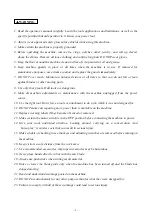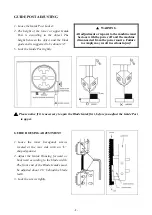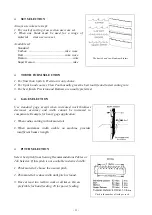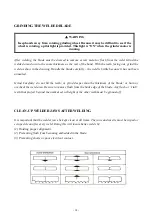
- 10 -
To get the most satisfactory work, it is important to choose a blade that is correct for the work.
Blade life, cut straightness, finishing quality and sawing efficiency is all related to the choice of
blade. Blade breakage, teeth stripping, crooked cuts, and other common complaints are, in most
instances, caused by using the wrong blades. Blades are classified by materials, tooth shapes, and
types of set.
KINDS OF BLADE
Bandsaw blades are available in specific sizes, or in 100 feet coils. They are made from several
different metals:
1.
Carbon Steel Blade: which are widely used because of their general adaptability for all types of
work and the low cost. They are excellent for cutting nonferrous metals and plastics.
2.
High-Speed Steel Blade: which resist heat generated in cutting to far greater extent than carbon
steel blades. They are best suited for cutting ferrous metals.
3.
Alloy Steel Blade: which are tougher and more wear resistant than either of the above. They will
cut faster and longer than blades of carbon or high-speed steel.
4.
Carbide-Tipped Blade: which are best used for cutting unusual materials such as uranium,
titanium, and beryllium. These metals are difficult to cut with other types of blades.
TOOTH SHAPES
The regular or standard tooth is preferred for all ferrous metals and general-purpose cutting. The
skip-tooth blade has widely spaced teeth to provide the added chip clearance needed for cutting
softer nonferrous materials. The hook, or saber tooth blades has a 10
°
undercut which permits better
feed and chip removal, it is best for the harder nonferrous alloys.
SET TYPES
Regular or rake set is generally furnished on saws that have 2 to 24 teeth per inch. These blades
have one tooth set to left, one to right, and one unset tooth called a rake. This set is used when
material is to be contour cut. Wavy set is furnished on saws that have 8 to 32 teeth per inch. This set
has groups of teeth bent alternately to left and right, which greatly reduce the strain on individual
teeth. Saws with wavy set are used where tooth breakage is a problem, such as in cutting thin stock
or where a variety of work is cut without changing blades.
Of the three common set patterns, only
raker and wave are now used in
metalworking.
Summary of Contents for VBS-2012H-CE
Page 1: ...OPERATOR S MANUAL VBS 2012H CE METALWORKING BANDSAW ...
Page 25: ... 24 ...
Page 28: ......
Page 30: ... 29 ...
Page 31: ... 30 ...


























